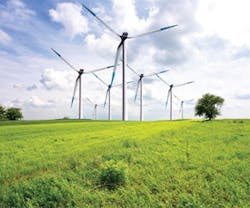Newsworthy
Keep Your Facility Up in a Down Economy
You want the quality of your facilities to go up, or stay steady, even when the economy is down. Joseph Yozzi, senior director of operations with UGL Unicco, discusses five steps to maintaining a facility in a down economy.
Buildings: What are the 5 main steps for building a better facility in a down economy?
Yozzi: 1. Create and maintain a facilities strategic plan that is aligned with the corporate organization mission and visions. Engage in an active dialogue with all stakeholders. Identify what key facilities outputs are necessary for mission success.
2. Sharpen your key performance indicators (KPIs) and communicate measurements throughout the organization. Measure and improve performance.
3. Know your costs. Categorize according to work breakdown structure using IFMA or other industry standards. Benchmark and work best in class. Focus on the 20% of the items that make up 80% of the costs.
4. Consider the intangibles. Sustainability, for example, doesn't always show up on the bottom line; yet it is a huge contributor to public image and employee morale, and it is "the right thing to do."
5. Proceed with caution, measure results, and take a long-term, life-cycle view. Short-term cost savings and "knee jerk" reactions can be very expensive, yet survival is necessary.
Buildings: How do these steps differ from building a better facility in a normal economy?
Yozzi: It is always wise to know your business. The difference is that in an economic downtime available resources can be severely constrained. Facilities operations are often the major portion of the business's indirect expenses, therefore, facilities will not be under close scrutiny. Of course, facilities operations will be affected. The goal, however, is to not become the "victim" of short-sited thinking.
Buildings: How do these steps differ with higher or lower budgets?
Yozzi: It may sound obvious, but the difference is the money. As stated before, the survival of the business may be at stake, Compliance to regulations, rules, and mandates is a legal and ethical responsibility. It is important to understand whether business is in an expansion or contraction mode. Be ready with your list of "must do" items as well as "nice-to-do" items. Being out of step with the business cycle can be destructive for the facilities manager as well as the facility. Facilities contributions in terms of goods and services need to match the times.
Buildings: How can you communicate added value or added savings when convincing clients to spend more on a better building?
Yozzi: A strong communications plan is important from the start. The process for communicating priorities and results, including the language of KPIs, needs to be established up front. This makes the "value proposition" the basis of the client relationship. If these communications only take place during a downturn, there will be a lot of playing catch-up.
Buildings: How can taking these steps impact your building, and the bottom line, in the long run?
Yozzi: As facilities managers and building operators we share in the success of the business. The work environment we provide impacts employee productivity and can affect employee recruiting and retention. Businesses are increasingly recognizing this enormous impact by placing facilities managers closer to the executive level, or "C Suite." That's right where we want to be — partnering for success.
To learn more about bettering your facility in a down economy and about Facilitease, UGL Unicco's new on-demand Webcast series, visit www.ugl-unicco.com/facilitease.
Sustainability in NumbersWhat would your company say when asked about sustainability?
Facility managers, manufacturers, distributers, and facility service providers were asked about sustainability in their workplaces in a recent online survey conducted by AlturaSolutions Communications.
When asked to define "sustainability," only 53% were correct in referring to "balancing financial, human, and the use of natural resources," while 26% believed sustainability only pertained to responsible use of natural resources.
Despite differing definitions, 63% planned to increase their organization's emphasis on sustainable practices over the next 12 months. The remainder either didn't know or had no planned changes.
When questioned on motivations for sustainability, 47% said their reasoning was from the belief that practicing sustainability is "the right thing to do." The remainder were split between government regulations and demands from clients as their incentive to become more sustainable.
Nearly half (47%) indicated that the economy would "have little impact" on sustainability efforts. Slightly fewer indicated that the economy would encourage sustainable work practices because of the "potential cost savings."
Most notably, when asked about publicizing their own company's efforts to become sustainable, 74% indicated plans to tell others.
"Companies are proud to shout it from the rooftop how they are conserving resources, protecting the environment, and saving money," says Stephen Ashkin, CEO of Sustainable Dashboard Tools, LLC
As Temperature Goes Up, Performance Goes DownThe performance of crystalline silicon, which is considered to be a reliable solar module construction, declines during rising temperatures of rooftop modules, according to studies by TUV Rheinland PTL, LLC, a member of the world's largest solar and photovoltaic testing network.
Most crystalline silicon photovoltaic modules are known to decrease by 0.5% per Celsius degree as the temperature increases. Govindasamy Tamizhmani, president of TUV Rheinland PLT, and Joseph Kuitche, operations section head of the same company, plan to show the link among module temperatures and weather conditions. The results of the study have the potential to impact the type of module set-ups that are installed in the future.
For more information, visit www.tuvpt.
18 Colleges Earn Perfect Green Rating
The Princeton Review has named 18 colleges to its 2011 Green Rating Honor Roll. The institutional survey for the rating includes questions on energy use, recycling, food, buildings, transportation, and action plans for reducing greenhouse gas emissions.
Here are some standout practices from these A+ universities:
- College of the Atlantic (Bar Harbor, ME): Has been carbon neutral since 2007. All electricity comes from renewable hydropower; new buildings are cleanly heated via renewable wood pellets.
- Northeastern University (Boston, MA): Has composted approximately 594 tons of dining hall service and catering food waste since 2008.
- Harvard College (Cambridge, MA): Home to 62 building projects seeking or awarded LEED certification.
- Unity College (Unity, ME): The president's home uses solar energy for electricity and hot water, and has zero net-energy consumption and carbon emissions. The house is built from local wood and recycled building materials.
- Northland College (Ashland, WI): Installed two wind towers, numerous solar panels, and geothermal heat across campus.
- Warren Wilson College (Asheville, NC): The LEED Platinum EcoDorm was built by student teams with wood that was repurposed or sustainably harvested on campus. It also features solar panel window awnings, compost toilets, and a rainwater catchment system that helps irrigate the adjacent garden. To view the full list, visit www.princetonreview.com/green
Athletic Departments Making Green a Priority
Move over Astroturf, college athletics have a new green underfoot. A growing majority of NCAA athletics departments are going up to bat for the environment, adding sustainable initiatives to their line ups. A recent survey, conducted by ProGreenSports, found that 52% of respondents described going green as a "high" or "very high" priority, an 8% increase from last year.
Over one-third of respondents are undertaking or actively considering a strategic sustainability plan with short- and long-term objectives. The survey focused on efforts related to energy, recycling, water conservation, and green building practices. The most pressing priorities were energy conservation and efficiency, as well as office and event recycling.
Despite the spike, the current economic downturn has caused a stalemate for some schools. Many have concerns about the "unclear return on investment" for green programs.
Google Invests in Wind Farm to Power Data Centers
Google has recently entered into a deal to buy wind power for the next 20 years. The deal has allowed Google to already start purchasing that clean energy as of July 30, 2010. The purchase comes as part of Google's efforts to become carbon neutral.
"On July 30 we will begin purchasing the clean energy from 114 megawatts of wind generation at the NextEra Energy Resources Story County II facility in Iowa at a predetermined rate for 20 years," says Google Vice President Urs Hoelzle in Google's blogspot.
Using the Google Energy unit, the company is able to purchase wholesale energy directly from the wind farm rather than through Renewable Energy Certificates (RECs) from third parties. However, because Google can't directly use the energy, it is reselling the energy to the grid in the regional spot market.
"By obtaining RECS through the purchase of green power, our deal has a greater impact on the renewable industry than simply buying 'naked' RECs from third parties," says a press release from Google. "Our long-term commitment directly frees up capital for the developer to build more wind projects.
By purchasing wholesale, Google has been able to combine cost-efficiency with a commitment to carbon-neutrality in this transaction. The wind energy will be enough to power several Google data centers.
Smart Grid Model Standard: Smart Idea
Teleportation may still be a thing of the future, but homes, commercial and institutional buildings, and industrial facilities are about to get "smarter" when it comes to electrical use.
Under a national smart grid effort, ASHRAE and the National Electrical Manufacturers Association (NEMA) are developing a standard to provide a common basis for electrical energy consumers to describe, manage, and communicate about electrical energy and forecasts.
The standard, ASHRAE/NEMA Standard 201P, Facility Smart Grid Information Model, will define an object oriented information model to enable applications and control systems in homes, buildings, and industrial facilities to manage electrical loads and generation sources in response to communication with a "smart" electrical grid, as well as to communicate information about those electrical loads to utility and other electrical service providers.
"NEMA and the members of their smart grid and high-performance buildings councils see the creation of this standard as a strategic element in driving development of a nation-wide smart electrical grid while increasing energy efficiency, occupant productivity, and cost-effectiveness in safe secure buildings," says Jim Lewis, High Performance Buildings, NEMA.
The proposed ASHRAE/NEMA standard will coordinate with work by the North American Energy Standards Board to develop a basic energy usage data model standard and create a facilities data model that provides additional energy usage data elements for commercial and industrial buildings.
How Much Have Your Electric Rates Increased?
Looking back over the past 5 years, has the electricity rate you pay for your commercial building increased, decreased, or stayed the same?
A recent survey of BUILDINGS readers shows that over 50% of respondents believe the rates have "increased somewhat" and 22% believe that rates have "increased significantly."
Of the remaining respondents, 13% believe that their electric rates have "stayed about the same" while only 7% believe that rates have decreased (6% believe rates have "decreased somewhat" and 1% believe rates have "decreased significantly").
In actuality, the average retail price of electricity to commercial customers has gone from 8.17 cents per kilowatt hour in 2004 to 10.21 cents per kilowatt hour in 2009 – a 25% increase.
The Not-So-Scary Truth About Bio-enzymatic Cleaners
While "bio-enzymatic" sounds new and scary, these cleaners are getting a closer look from many cleaning professionals and facility managers – perhaps because they can complement a green cleaning program.
Because the name of these cleaners sounds complex, many have questions about the cleaners and how they work. The following information addresses some of the questions and misconceptions:
- Bio-enzymatic cleaners contain specific quantities and qualities of bacteria, along with enzymes (a type of protein that breaks complex molecules into smaller pieces) and microbial nutrients that essentially digest chemical and organic waste.
- In many cases, bio-enzymatic cleaners can provide immediate odor relief, because odor-causing bacteria are "food" for these microorganisms.
- The bacteria consumed by the bio-enzymatic cleaners are converted into carbon dioxide and water.
- Some bio-enzymatic cleaners are designed to work up to 80 hours after the cleaner is applied.
- Bio-enzymatic cleaners may be safer for users and the environment than traditional cleaning chemicals – especially if the cleaner has been green certified.
- Bleach and disinfectants should not be used in conjunction with bio-enzymatic cleaners. These agents can reduce or eliminate the effectiveness of the bio-enzymatic cleaner, as well as the microbial efficacy of the bleach or disinfectant.
"Bio-enzymatic cleaners are not going to replace green cleaning products," says Mike Sawchuk, vice president of Enviro-Solutions and Charlotte Products. "But, because many newer bio-enzymatic cleaners perform well, are environmentally preferable, and cost effective, we can expect them to play an even greater role in green cleaning in the future."
Affordable Housing Revitalizes Neighborhoods
Affordable housing development fuels economic gains in distressed neighborhoods, according to a new study of New York low-income housing. The study, commissioned by Local Initiatives Support Corporation (LISC) and Enterprise Community Partners, shows affordable housing development is a proven economic stimulus that can expand neighborhood spending power, raise surrounding property values, and help low-income families stabilize their financial situations.
The study points to three conclusions that can connect to a significant return on the LIHTC (Low-Income Housing Tax Credit Program) investment.
- Family financial stability: Families in affordable housing more than double their discretionary income. In the Bronx, researchers noted a 12% immediate annual return to residents living in a development that received Low-Income Housing Tax Credit investment, based on the additional disposable income available to residents.
- Increased local purchasing power: Affordable housing boosts business for nearby merchants. By paying rents within their means, residents of a cluster of Bronx rental developments expanded estimated local purchasing power by more than one-third.
- Higher property values: LIHTC project investments increase adjacent property values and help generate additional property tax revenue. More specifically, they increased the value of surrounding properties by 6% right away and resulted in consistent increases over time.
"Quality affordable housing alone cannot solve all a neighborhood's problems," says Denise Scott, executive director of New York LISC. "But it anchors so many positive developments within a community. Affordable housing creates jobs, contributes to safer streets, supports neighborhood retail, and encourages economic stability among resident families. It is a critical part of a comprehensive approach to neighborhood revitalization." Copies of the study are available at www.lisc.org and www.enter prisecommunity.org.
Summer Cleaning Checklist for Healthcare
As bed turn rates decline, the summer months give environmental service (ES) departments time to recharge and prepare for the next flu season. ES directors can maximize this downtime by developing a summer maintenance plan. Developed by the Cintas Corporation, here is a checklist of best practices to get you started:
- Deep clean all soft surfaces, such as carpet, clinical, and non-clinical areas throughout the building. Use a carpet cleaning service that allows floors to dry quickly, limiting downtime and poor indoor air quality.
- Deep clean all hard surfaces outside the building. This includes cement walkways leading into the hospital where chewing gum or stains may have developed. Stains and dirt outside the building may cause patients to question cleanliness inside the building.
- Deep clean all hard surfaces inside the building. Pay particular attention to areas between hard surfaces, such as grout lines, which can be breeding grounds for organic soils and bacteria.
- Conduct training sessions to instruct ES workers on proper infection control to prevent cross contamination when cleaning patient rooms and high-risk areas.
- Review the building matting program. Entryway mats are the first line of defense for preventing dirt from entering the building, so it is important that mats are the right length and are regularly cleaned.
- Assess opportunities for environmental savings. Even if you're not using green chemicals, you can reduce the amount of water and energy consumed.
- Evaluate your microfiber program. Ensure microfiber is laundered at the correct temperatures to prevent deterioration and is compliant with OSHA Standard 1910.1030.







